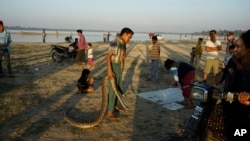Australian scientists, working with counterparts in Myanmar, are hoping to reduce Myanmar's high death toll from snake bites in rural communities, especially among vulnerable populations facing inadequate emergency care.
The official toll from snake bites in Myanmar is 600 deaths a year out of some 13,000 cases among a rural population dependent on rice harvesting for a living. But rice paddy fields and rice stacks lure rats and mice, and in turn draw snakes, the most venomous being the Russell’s vipers and cobras.
But the hopes for survival are often challenged by long distances from emergency care, with poor roads and infrastructure between snake bite victims and life-saving medical treatment.
Chen Au Peh, a renal specialist at the Royal Adelaide Hospital in South Australia, said speedy access to emergency medical treatment is crucial.
“So all these factors accumulate to a long delay between bite and administration of an anti-venom. So to help them, we have to help them produce more anti-venom, to get the anti-venom to where it's required to help them keep the anti-venom in the refrigerator and to help the health professionals,” Peh said.
Lifestock also affected
The project has also involved ensuring higher survival rates of horses used in the production of the anti-venom after being injected with snake venom. High mortality rates were evident among the horses due to anemia, nutritional problems and veterinary practices. Changes in practice included learning the skills developed by Myanmar horse handlers.
“In the last 10 months the average horse mortality is something like six or seven per month – compared to 50 per month – and this is very good news not only for horses but for human patients who may need the anti-venom. The more horses that survive the month, the more vials of anti-venom you can produce,” Peh said.
As a result, production of anti-venom has risen sharply to 100,000 vials from 60,000 vials.
The team’s work, part of a $1.77 million effort begun in 2014 with support from the Australian Department of Foreign Affairs and Trade (DFAT) and working with Myanmar’s Ministries of Industry and Health, is focused on the northern city of Mandalay, a region that faces an estimated 700 to 800 snake bite victims each year.
The Australian team, which includes Afzal Mahmood, a senior lecturer in public health at the University of Adelaide and Julian White, a world renowned toxicologist from the Women's and Children's Hospital in Adelaide, is working with specialists in Myanmar and local partners on guidelines, protocols and standard operating procedures for the health sector.
Real numbers higher
Mahmood said a recent survey indicated the rate of snake bites was considerably higher than official figures.
“It is not a new phenomenon, it happens because many people do not reach the health system where recording takes place. Some people get treated by the traditional healers; some may die without actually reaching the health system and some may suffer and get healed,” Mahmood told VOA.
But he said the program has succeeded in boosting the skills among the local medical and non-medical community.
“We have produced revised guidelines for the doctors [and] some diagnostic tests, and the training of some 200 health care providers,” he said.
The work has reached about 150 villages with local community meetings targeting around 7,000 people to promote awareness of snake bite treatments.
The goal, the scientists said, is to shorten the time to treatment by providing solar powered refrigerators near to local communities with supplies of anti-venom.
Mahmood says the challenges go beyond the initial treatment.
“Psychological issues post-bite [affect] not only the person but the family themselves suffer. It’s a very life-changing experience,” he said.
Victims of snake bites are among Myanmar’s poorest. They often face long periods of hospitalization, leaving families facing high medical bills, often equivalent to several months of real earnings as they struggle to meet hospital and transport expenses, even those receiving subsidies.
To ensure the project is sustainable, its goal is to provide a model that can be applied elsewhere in Myanmar.







